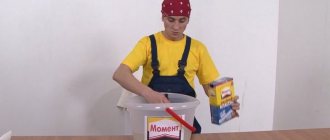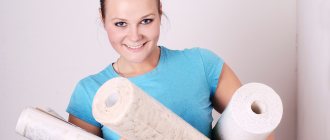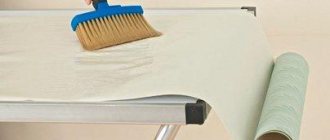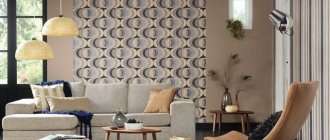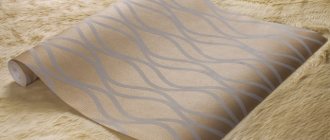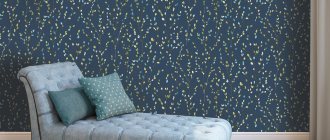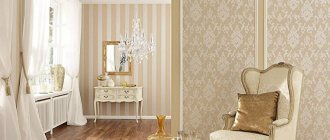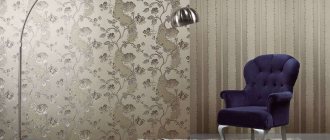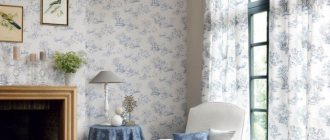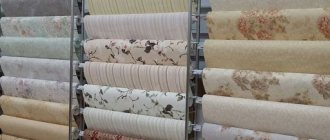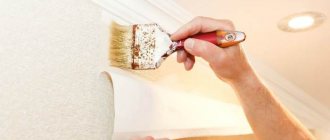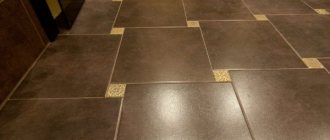Vinyl wallpaper takes pride of place in the ranking of building materials. They differ in the density of the fabric. The modern market offers a very wide range. Vinyl wallpaper can level even the most problematic areas of the surface. This effect is achieved due to their relatively heavy weight. It is this specificity that requires good glue. Therefore, during construction and repair work, it is important to choose high-quality adhesive for vinyl wallpaper. But, just like other materials, adhesives are also diverse and differ in modifications.
Wallpaper base
We will talk exclusively about non-woven products. These are heavy and massive options that are made from cellulose. They have a lot of positive qualities. Such products can be used for painting.
For example, all wide vinyl wallpapers in all cases have a non-woven fabric. The rolls usually have a special mark “for non-woven fabric”. These are the products that should be purchased to be applied to the wall.
Hot stamped vinyl wallpaper on non-woven backing
The characteristics of hot stamping wallpaper can be considered enviable. What is hot stamping? It is a two-component coating, the base of which is made of non-woven material, and the decorative layer is made of foamed vinyl. The material is passed through a heating chamber, where the vinyl layer is softened. The surface itself is then treated with rollers, thus forming the relief of the decorative layer.
The difference between these wallpapers:
- They are very durable, only fiberglass can compete with hot-stamped wallpaper for primacy;
- Hanging such wallpaper is not difficult - the level of adhesion is high, the wallpaper sticks well, stretches, and is easy to work with.
Walls with hot-stamped wallpaper pasted can be washed with a regular sponge using mild detergents
And, of course, it’s worth talking about the harm. Manufacturers themselves say with confidence whether hot-stamped wallpaper is harmful - no, it is not harmful. At the same time, they foresee the following argument: in the process of hot stamping, formaldehyde burns out of vinyl. Namely, formaldehyde is harmful to human health.
Types of glue
There are 4 types of products for:
- paper;
- vinyl;
- non-woven;
- glass wallpaper.
In our case, glue for non-woven wallpaper is suitable. Its peculiarity is that it is applied not to the canvas, but to the wall. However, the rest of the composition is very similar, and modified starch is used. A number of special additives are used to combat mold and mildew.
In order to dilute the composition, you must follow the instructions on the package. The principle of working with glue depends on what composition the manufacturer uses. The packaging must indicate all the components that each company uses for production.
Voting for the best adhesive for vinyl wallpaper
What adhesive would you choose or recommend for vinyl wallpaper?
Semin Sem Vinyl
0.00 % ( 0 )
"Snowflake -3" Melate
25.00 % ( 1 )
Kiilto Master Pro
0.00 % ( 0 )
Lacra vinyl
0.00 % ( 0 )
KLEO total
0.00 % ( 0 )
Moment Vinyl
0.00 % ( 0 )
Axton vinyl
0.00 % ( 0 )
Quelid vinyl indicator
0.00 % ( 0 )
Quelid special interlining
25.00 % ( 1 )
PUFAS Euro 3000
25.00 % ( 1 )
Tytan Euro line vinyl with indicator
0.00 % ( 0 )
Metylan
0.00 % ( 0 )
Product Features
Before choosing, you must take into account a number of features that will allow you to understand how high-quality the composition you are using:
- when stirring the glue there should be no clots or lumps;
- storage in packaging can reach a very long time;
- high-quality products protect against the formation of fungus and mold;
- it must be safe for health;
- The preparation process is indicated on the package and even a beginner can perform it.
If the glue has all these characteristics, then most likely you are buying a quality product. Preparation of the solution takes no more than 10 minutes.
Non-woven vinyl wallpaper: reviews
If you analyze the reviews, you can roughly make a list of the advantages and disadvantages of wallpaper, which are most often noted by customers.
Pros and cons of non-woven vinyl wallpaper:
- Pros - wallpaper is durable, highly abrasion-resistant, high-quality, impressive in appearance, affordable, easy to care for, large selection.
- Cons - problems may arise with the glue; sometimes even the wrong proportions are indicated on the glue packaging, which is why heavy wallpaper falls off.
Related article: Flowerbed, furniture, mushrooms and other crafts from an old tree stump for a summer residence (39 photos)
Judging by the reviews, you can’t skimp on glue, and some even prefer to dilute wallpaper glue with PVA glue, assuring that a thicker composition holds the wallpaper better.
As for brands, German and Italian wallpapers are held in the highest esteem. Italy is famous for keeping up with fashion and even being ahead of it.
A rich palette of colors and prints, imitation of natural materials (sometimes it seems that this is not wallpaper at all, but expensive fur), design for a specific interior style - all this is Italy, its quality and style
Germany is all about advanced technology and refined taste. And German wallpaper, and if the manufacturer is Italy, will not cost, let’s say, three kopecks. Therefore, if you are assured that the wallpaper is branded, Italy, the latest collection, but a roll costs three hundred rubles, is it worth talking about quality?
How to make a selection
In order to choose the right materials, you need to look at the type of coating and its weight. In addition, special attention is paid to the walls in the room, humidity and constant temperature.
Glue consumption is also considered an important factor. Each manufacturer indicates on the packaging how long one pack can last. It is better to choose a mixture that has antiseptic properties.
A very important advantage of such a solution is that it needs to be applied to the wall, and not to the canvases themselves. This is a very important factor. But it is important to do this only on flat surfaces.
Designations on vinyl wallpaper with non-woven backing
You can rely on the same symbols that are found on other types of wallpaper. But before you directly stick the wallpaper on the wall, look at how many symbols are on the label.
The most common designations are:
- One wavy line . Fresh stains are removed with a sponge.
- Two wavy lines . Small dirt can be removed with a damp sponge.
- Three wavy lines. If the dirt dissolves in water, you can use soap and a damp sponge.
- Wavy line and brush. Naturally, we are talking about the fact that you can use a sponge and a brush (soft).
- Three wavy lines and a brush . It is allowed to use a damp sponge, brush, soap or cleaning agent.
Basic designations that can be seen on rolls of vinyl wallpaper
There are also symbols indicating pattern adjustment, light fastness, and rules for how to paste and remove wallpaper. These icons are almost all clear and do not require decoding. Be sure to look at the signs listed above, which dictate what to wash and how to wash such wallpaper. Incorrect care harms the wallpaper; care for it correctly according to the instructions.
What to do if the glue remains on the front side of the wallpaper?
During repairs, situations arise when a small part of the solution gets onto the outer, front side. At this point, you will have to use a spray bottle filled with warm water. It must be sprayed onto the area where the composition has spilled.
After getting completely wet, carefully wipe the wall with a soft cloth. But you need to do this very carefully so as not to spoil the material.
If the mixture has not cooled down yet, you can try to remove it simply with a damp cloth. There are also special products that remove various stains from walls and wallpaper.
How to calculate the required amount of wallpaper
To make it easier to explain, I will split this into two options for calculating rolls per room. And I will try to explain clearly. I will be counting rolls that are 10 meters long and 1 meter wide; they are the most popular now. Let's get started.
The first will be for a standard room, where the walls are 2.5 meters, and the wallpaper is very simple, in which you do not need to select a pattern.
The first thing we do for both options is to calculate the perimeter of the room. We add up all the sides and get the result.(5+3+5+3=16). 16-perimeter/1 is the width of the wallpaper/4 number of stripes=4 rolls per room. We divide our roll by the height of the walls, it will be 4 (10/2.5=4). This means there are 4 strips in one roll, one strip is 1 meter, the perimeter of the room is obtained, 16/4, 4 rolls come out.
Let's consider another situation, we calculate the perimeter (5+4+5+4=18), also 1 roll is enough for 4 strips, now 18/4=4.5, we need to round up, we buy not 4 rolls, but 5, otherwise it may not be enough .
The second is the opposite of the first, the walls are more than 2.5 meters, and it is necessary to select a pattern. It may happen that these two factors coincide together, and you will have to calculate both.
Manufacturers
If you choose vinyl wallpaper on a non-woven basis, what kind of glue is needed is also a very important question. This determines how much you will use it when breeding, as well as whether it can withstand the load from fairly heavy canvases. There are several main manufacturers that are currently represented on the market. Product consumption is indicated on the pack, but it is better to take a little more, since some types of walls may consume more material.
Quelyd
A company from France, Kelid, produces its own line of products that are specifically suitable for non-woven bases. One pack is enough for three meter rolls. If the pattern is bulky and heavy, then the consumption will increase significantly. But such glue will allow you to install wallpaper efficiently.
Cleo
Cleo adhesive for non-woven vinyl wallpaper is also produced in France and is a fairly good product. The quality of the glue is comparable to what the Kelid company produces, so you shouldn’t expect anything fundamentally new from the product. Be sure to select a little more glue than indicated on the pack.
Methylane glue
One of the most popular adhesives is methylane. It received wide publicity through advertising. Yes, its quality is undeniably high, but it is worth noting that the price is also at a very high level. The manufacturing company also produces more budget options.
Can choose:
- Econ is extra strong;
- Moment Interlining;
- Methylane Interlining Ultra Premium.
Each of these products has similar characteristics, for the most part. The only difference between them is the price, which can vary in different directions. This way, you can definitely find the option that suits you. Methylane adhesive for non-woven vinyl wallpaper is one of the best choices at the moment.
What to look for when purchasing?
When choosing an adhesive, it is important to always pay attention to the information on the packaging. Usually it provides complete information on the conditions of use, temperature requirements and other important points. If the wallpaper is intended for a room with high humidity, then the glue must be waterproof.
Be sure to check whether the adhesive contains antifungal components. Vinyl wallpaper does not allow air to pass through. This creates a favorable environment for the proliferation of harmful microorganisms.
Don't choose brands that are too cheap. A glue with a good composition cannot be too cheap. But high cost does not guarantee quality. So the only sure way to choose the best adhesive for vinyl wallpaper is to carefully study the product you are purchasing.
Video - How to glue vinyl wallpaper
Conclusions on the topic
Thus, we became acquainted with the topic of whether it is possible to use vinyl adhesive for gluing non-woven wallpaper. By and large, both vinyl and non-woven wallpapers, with rare exceptions, are quite dense, so their adhesive strength will be very similar. If you decided to glue cheap paper wallpaper with vinyl glue, then difficulties would be inevitable. In the case of gluing non-woven wallpaper with vinyl glue, everything should go well, however, if you are gluing expensive non-woven wallpaper, then we recommend not saving, but using glue that is suitable for the specific wallpaper. This way you will protect yourself, because remember - the stingy pays twice.
If you want to share your experience or have any questions on this topic, then we are waiting for you in the comments to this article. Tell us how your wallpaper is doing and ask your questions, and our authors and readers will answer you.
Happy renovation!
Preparing the walls
Preparing walls for pasting is a responsible job. If it is not done well, thinking that nothing will be visible under the wallpaper. This is not true, now we know that the wallpaper is different, and some canvases even highlight all the flaws that were on the wall.
So, such work must be approached responsibly, no matter how you admire your work later.
How to remove old wallpaper
Before pasting the walls again, you must definitely remove the old wallpaper; if the wall is concrete, then we remove it right down to the concrete, without the slightest residue of paper on the wall.
Particularly difficult to remove are those pieces that did not come off immediately along with the main part. Don't worry, this happens quite often, you just have to be patient, work and work.
To remove difficult pieces of paper from the wall, in addition to drywall, we will need a knife, with which we need to make cuts up to the wall and spray it with a spray bottle; it is better to use warm water with liquid soap or detergent.
Moisten generously with water, and the cuts will help strengthen and speed up this wetting process. Then take a spatula and tear off the wet paper.
Wallpaper can be removed from drywall using water and detergent; the only thing you shouldn’t do is cut it with a knife, otherwise you can damage the protective cardboard layer that protects the plaster.
The myth that the wallpaper comes off together with the drywall layer is not true; they are removed quite carefully and do not harm the drywall surface.
Puttying irregularities
If the walls are not level or have chips or cracks, then puttying is necessary. The first thing it is advisable to do is cover the floor with paper.
Next, we begin to apply the putty from bottom to top, then take a wide spatula and level it. The first layer is ready, we wait for it to dry, this will require a certain amount of time, perhaps a day.
Then we take fine sandpaper and sand the putty areas; if the result is not satisfactory, this happens when large cracks are puttied. In this case, repeat the puttying.
Well, we sanded it a second time, and the result is excellent, then we collect fine dust from the walls and floor with a vacuum cleaner. The puttying is complete, now you can glue the wallpaper or just paint it.
Is it necessary to prime the walls?
I would say that it is necessary to prime the walls, but it depends on your desire. After priming, the wall is impregnated with a special liquid, good adhesion of the materials is obtained, and an antifungal agent is also added in some compositions.
When priming occurs before puttying, it cleans the walls of fine dust or other contaminants. On a primed wall, the putty adheres and holds better. If this is not done, the putty may crack and fall off.
After priming, you can be sure that it will not begin to peel off. Do not skimp on the primer; it can be used before each manipulation, that is, before puttying, the first and second layers, before applying the mesh. Draw your own conclusions, I recommend priming.
Tools and materials
Non-woven wallpaper used for interior work can have a top layer of different types - vinyl, paper, acrylic, textile. If you plan to glue vinyl or any other non-woven wallpaper, you will need to calculate the required number of rolls. Prepare your tools:
- rollers (one is useful for applying glue, the other is needed for rolling the surface);
- brushes (for hard-to-reach areas);
- scissors or stationery knife;
- marker or pencil;
- level (laser/conventional) or plumb line;
- roulette;
- putty knife;
- container for adhesive mixture;
- sponge and dry rags.
At the preparatory stage, you cannot do without primer mixtures and putty. To apply the primer you need a roller and a brush. Gluing surfaces is carried out only with the help of glue intended for non-woven materials. It is convenient to smooth out the stripes with a rubber or plastic spatula.
What must be observed after completion of work
First, under no circumstances open windows and doors, no drafts, no heat guns or fans, otherwise the wallpaper will fall off. Also maintain the temperature regime, it should not be cold, in which case the adhesives will take much longer to dry and will be too hot.
After pasting, you need to let them dry for a day, or even two. Some people prefer to cut off the excess wallpaper after it has dried, so anyone who does this should of course trim it.
It seems that I wrote everything I wanted, I hope everyone understands. So choose the right canvases and the appropriate glue for them. I promised to talk about the fire resistance of such wallpaper, but this is really the case, they hold a certain fire temperature, do not ignite for a very long time, but this is not good, the top layer is made of special foam, and, as you know, foam, before it catches fire , releases toxic substances into the air along with smoke.
Yes, the wallpaper will not yet have time to catch fire from the fire, but its toxic smoke can already cause harm to your health. Unfortunately, many of these wallpaper batches are fake, and on each package they write that they are fire resistant and that they are safe. Be aware that wallpaper can cause irreparable harm to health.
